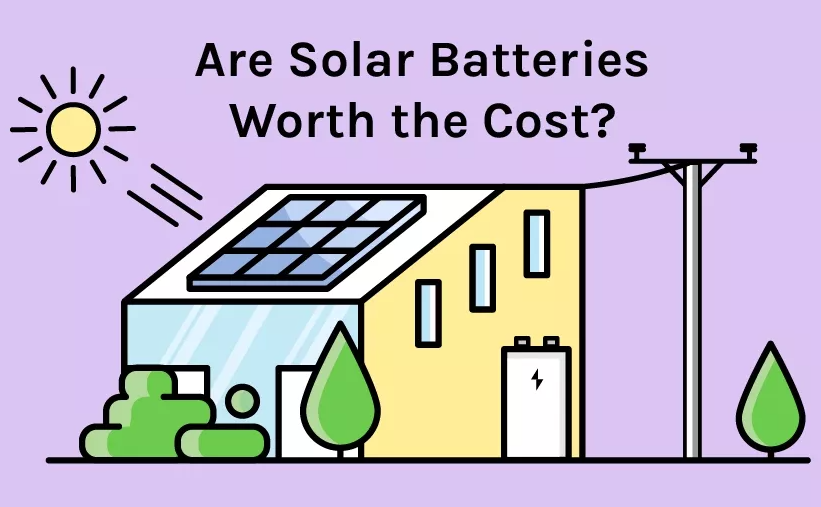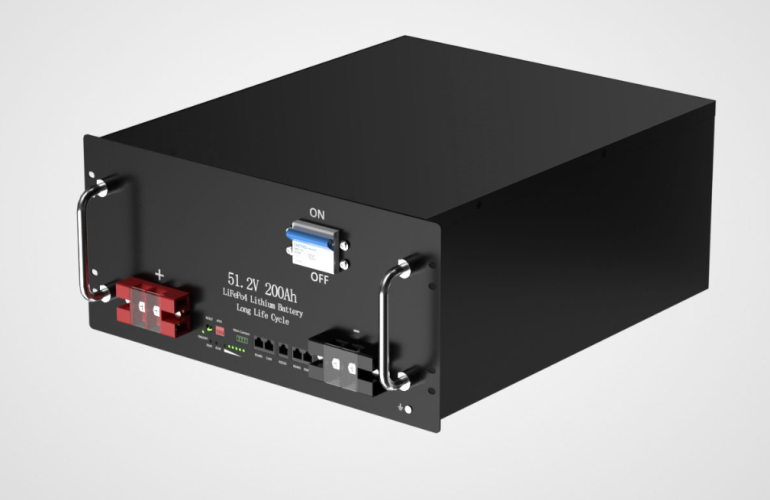If you’ve been considering installing a solar panel system recently, chances are you’ve come across the topic of solar batteries. Despite the growing popularity of battery systems, many homeowners still lack sufficient knowledge about them.
Whether you’re a newcomer to the world of solar power and seeking the best system for your property or you’ve had solar panels adorning your home for years, integrating a solar battery can significantly enhance the efficiency and versatility of your solar setup. Solar batteries store surplus energy generated by your solar panels, allowing you to power your home during gloomy, rainy days, or after sunset.
In this blog, we will delve into the benefits and downsides of solar battery storage to help you determine whether it’s a worthwhile investment for your solar energy endeavors. Whether you’re a novice or an experienced user, this information will aid you in making an informed decision.
What Are Solar Batteries?
A solar battery is a device that stores electric charge in chemical form, and you can use that energy at any time, even when your solar panels are not generating power. Although the battery backup systems that are coupled with solar panels are often referred to as solar batteries, they can store charge from any electricity source. This means you can recharge a battery with grid power when solar panels have low productivity, or you can use other renewable sources such as wind turbines.
There are different types of battery chemistries, each with advantages and limitations. Some types of batteries are suitable for applications where you need a large amount of energy in a short time, while others work best when you need a steady output over a longer period. Some common chemistries used by solar batteries are lead-acid, lithium-ion, nickel-cadmium and redox flow.
When comparing solar batteries, you should consider both the rated power output (kilowatts or kW) and energy storage capacity (kilowatt hours or kWh). The rated power tells you the total electrical load you can connect to a battery, while the storage capacity tells you how much electricity a battery can hold. For example, if a solar battery has a rated power of 5 kW and a storage capacity of 10 kWh, you can assume:
- The battery can power up to 5,000 watts (or 5 kW) of the electrical load simultaneously.
- Since the battery stores 10 kWh, it can sustain a maximum load of 5 kW for two hours before depleting its charge (5 kW x 2 hours = 10 kWh).
- If the battery powers a smaller load of only 1,250 watts (or 1.25 kW), it can last for eight hours with a full charge (1.25 kW x 8 hours = 10 kWh).
It’s important to note that the rated power of solar panels and battery storage systems are not the same. For example, you could have a 10 kW home solar system with a battery that has a rated power of 5 kW and 12 kWh storage bank.
How solar batteries work
Solar batteries store the extra solar energy your panels produce that you don’t immediately use so that you can draw from it later.See, solar panels produce the most electricity during the middle of the day, which also happens to be the time when your home uses the least amount of electricity. A standard grid-tied solar system sends that excess solar energy back to the utility grid.
However, when solar panels are paired with a home battery, excess electricity goes into the battery instead of the grid. Then, when the sun goes down and your panels aren’t producing electricity anymore, you can use the energy you have stored in your battery – instead of paying for electricity from the utility. This means you get to power your home with all of the clean, renewable solar power your solar panels produce, no matter what time of day it is.
Solar Battery Types
The four main types of batteries used in the world of solar power are lead-acid, lithium ion, nickel cadmium and flow batteries.
Lead-Acid
Lead-acid batteries have been in use for decades and are one of the most common types of battery used in automotive and industrial applications. They have a low energy density (meaning they cannot hold much energy per kg of weight), but remain both cost-effective and reliable and thus have become a common choice for use in a home solar setup.
Lead-acid batteries come in both flooded and sealed varieties and can be classified as either shallow cycle or deep cycle depending on the intended function and safe depth of discharge (DOD). Recent technological advancements have improved the lifespan of these batteries and lead-acid continues to be a viable option for many homeowners.
Lithium-Ion
The technology behind lithium-ion batteries is much newer than that of other battery types. Lithium-ion batteries have a high energy density and offer a smaller, lighter and more efficient option. They allow the user to access more of the energy stored within the battery before needing to be recharged, making them great for use in laptops and phones—and in your home.
The major drawback of lithium-ion batteries is the significantly higher cost to the consumer. If improperly installed lithium-ion batteries also have the potential to catch fire due to an effect called thermal runaway.
Nickel-Cadmium
Nickel-cadmium batteries are rarely used in residential settings and are most popular in airline and industrial applications due to their high durability and unique ability to function at extreme temperatures. Nickel-cadmium batteries also require relatively low amounts of maintenance when compared to other battery types.
Unfortunately, cadmium is a highly toxic element that, if not disposed of properly, can have a significant negative impact on our environment.
Flow
Flow batteries depend on chemical reactions. Energy is reproduced by liquid-containing electrolytes flowing between two chambers within the battery. Though flow batteries offer high efficiency, with a depth of discharge of 100%, they have a low energy density, meaning the tanks containing the electrolyte liquid must be quite large in order to store a significant amount of energy. This size makes them a costly and impractical option for most household use. Flow batteries are much better suited to larger spaces and applications.
Advantages and disadvantages of solar lithium batteries
Advantages of Solar Lithium Batteries:
- High Energy Density: Solar lithium batteries have a high energy density, meaning they can store a large amount of energy in a relatively small and lightweight package. This makes them ideal for applications where space and weight are critical factors.
- Long Lifespan: Compared to traditional lead-acid batteries, solar lithium batteries generally have a longer lifespan. They can endure a greater number of charge-discharge cycles, leading to extended usability and reduced maintenance costs over time.
- High Efficiency: Solar lithium batteries are known for their high charge and discharge efficiency, meaning they can convert a larger percentage of the stored energy back into usable electricity. This efficiency translates into better overall performance and utilization of solar power.
- Fast Charging: Lithium batteries can charge at a faster rate compared to other battery types. This allows for quicker recharging from solar panels, ensuring the battery is ready to store energy during periods of peak sunlight.
- Lightweight and Portable: The lightweight nature of lithium batteries makes them easier to handle and transport, making them suitable for off-grid and mobile applications, such as camping or RVs.
Disadvantages of Solar Lithium Batteries:
- Cost: Solar lithium batteries can be more expensive upfront compared to other battery technologies, such as lead-acid batteries. However, the costs have been decreasing over time due to advancements in technology and increased demand.
- Safety Concerns: While lithium batteries are generally safe, there have been rare cases of thermal runaway and fire incidents. Proper installation, monitoring, and use of battery management systems are essential to mitigate potential safety risks.
- Limited Availability of Raw Materials: Lithium-ion batteries rely on specific rare earth elements, and as demand increases, there may be concerns about the availability and responsible sourcing of these materials.
- Capacity Fade: Over time, the capacity of lithium batteries can gradually decrease due to chemical reactions and aging. However, proper battery management practices can help mitigate capacity loss and extend the battery’s usable life.
- Disposal and Recycling: The recycling and disposal of lithium batteries require specialized processes to handle the potentially hazardous materials properly. Proper recycling and waste management are essential to minimize environmental impact.
In summary, solar lithium batteries offer several advantages, including high energy density, long lifespan, and high efficiency. However, they also come with some drawbacks, such as initial cost, safety concerns, and the need for responsible recycling practices. Evaluating these factors can help users make informed decisions regarding the suitability of solar lithium batteries for their specific energy storage needs.
Things to Look for When You’re Picking a Solar Battery
Several factors contribute to the performance of your solar battery. Before choosing your battery system, consider the following:
Type or Material
Among the types of batteries to choose from, each type offers a different major advantage. Weighing these pros and cons can help you decide which style is right for you. If you’re looking for something compact and longer-lasting, lithium-ion may be right for you. Lead-acid might be better for those conscious of more immediate budget constraints.
Battery Life
The “lifespan” of any battery is multifaceted; the age, type, quality and depth of discharge of the battery all contribute to its longevity. Referring to the manufacturer’s specifications for a battery can help you determine how long it’s likely to last.
In general, lead-acid batteries can last anywhere from one to 10 years depending on how they’re used. Lithium-ion batteries typically last seven to 15 years.
Depth of Discharge
Depth of discharge refers to how much of a battery’s stored energy is used before the battery is recharged. Typically, the deeper the battery is discharged, the shorter its lifespan will be.
Batteries often come with both a cycle life estimate (indicating how many cycles it will last given a particular depth of discharge) and a recommended maximum depth of discharge.
Both lead-acid batteries and lithium-ion batteries will decay more quickly when deeply discharged, but lead-acid batteries tend to offer a lower tolerance for deep discharges than lithium-ion batteries, significantly reducing life expectancy if deeply discharged on a regular basis.
Efficiency
Solar systems and batteries are not 100% efficient when transferring and storing the collected solar energy from panels to batteries, as some amount of energy is lost in the process. Depending on the amount of energy you’re able to generate from your panels and how your system is configured, it may be worth investing in a more expensive, more efficient battery. This can help save money long-term.
Are Solar Batteries Worth It?
Solar batteries represent a significant upfront financial investment, but can ultimately help save you money on energy costs after sundown or during an emergency. If you’re living off-grid, they may be critical components of your energy system.
Solar batteries provide your home with clean, fairly green, renewable energy that would otherwise need to come from an outside source. Some areas also provide incentives or rebates to help mitigate the costs of adding a solar battery to your system and it’s possible to receive up to 30% off of your battery installation if you qualify for the federal solar tax credit.
Ultimately, only you can decide if the investment in a solar battery and its rewards is worth the cost and upkeep requirements.
Frequently Asked Questions About Solar Batteries
Which battery is best for solar?
Lithium-ion batteries are considered the best option for home solar power systems since they can achieve a long service life even under a daily charging cycle.
What is the average cost of a solar battery?
The price varies depending on the brand and model, but the average price is around $800 to $1,000 per kWh of battery capacity.
How long do solar batteries last?
Solar batteries last for about 5 to 15 years. The life of the solar battery depends on its type, how well it’s maintained and how frequently it gets used.
How long do solar batteries hold charge?
The length of time your solar battery will hold a charge depends on the battery and the amount of energy being stored. A standard solar battery will store energy for one to five days.
Is it a good idea to get a battery with solar panels?
Using a solar battery helps you generate, store and use your power on your terms and enjoy life without the hassle of blackouts or high electrical bills.




